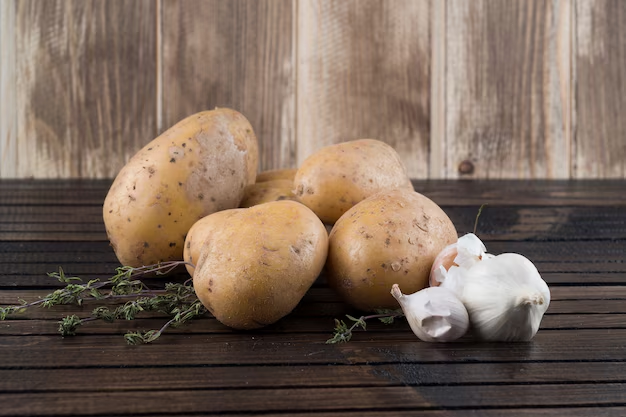Have You Been Storing Potatoes Wrong? The Real Story about Refrigeration
Think you know where to stash your spuds for optimum shelf life? Let’s dive into the great potato debate and discover the best way to store these kitchen staples.
🥔 Why Storage Matters: Understanding Potatoes
Structure and Composition
Potatoes are more than just a comforting side dish. As tubers, they are an underground energy reserve for the potato plant, primarily composed of starches. These starches convert to sugar under certain conditions—a critical point that will shape our discussion on refrigeration.
Common Varieties
Different potato varieties, including Russets, Yukons, and Reds, have distinct flavors and textures. Each type may react differently to storage conditions, affecting your choice of storage method.
The Case Against Refrigeration
The most common advice circulating is to avoid storing potatoes in the refrigerator. Here's why this advice exists:
❌ Sugar Level Increase
Refrigerating potatoes at low temperatures can cause their starches to convert into sugars. This not only alters their taste—making them oddly sweet—but also affects their cooking behavior, leading to unexpected results, especially in fried recipes like French fries.
❌ The Acrylamide Factor
When you fry or bake refrigerated potatoes, the increased sugar content can lead to higher levels of acrylamide. Acrylamide is a chemical concern for many consumers, making this a significant factor to ponder.
❌ Texture Changes
Cold temperatures can change the texture of potatoes, often making them gritty. While this won't make your potatoes inedible, it can detract from their traditional appeal, especially when aiming for that creamy mash or crisp fry.
Optimum Potato Storage Conditions
So, if the refrigerator isn't the best option, what's the ideal setup for storing your potatoes?
🍂 Cool and Dry
Store your potatoes in a cool, dry place. This means an environment that maintains a steady temperature without frequent fluctuations. Ideal spots include a pantry, a basement, or a ventilated storage box.
🌑 Avoid Light
Light exposure can cause potatoes to turn green, indicating the presence of solanine, a bitter-tasting, mildly harmful compound. Dark storage conditions can keep solanine levels low and your potatoes toxin-free.
🌬️ Proper Ventilation
Good airflow helps prevent moisture accumulation and reduces the risk of rot. Ensure your storage spot allows air circulation to keep your potatoes fresh for longer.
📅 Natural Lifespan
Potatoes are best used within weeks of purchase for optimal freshness and flavor. Aim to cycle through your supply, consuming the oldest ones first.
🗒️ Summary Chart: Storage Dos and Don'ts
| Storage Tip | Reason |
|---|---|
| Keep in a cool, dry place | Prevents sprouting and maintains starch balance |
| Store in the dark | Avoids solanine buildup |
| Ensure ventilation | Reduces rot risk |
| Use within a few weeks | Maintains peak freshness and taste |
Special Considerations
👩🍳 Cooking and Storing Cut Potatoes
If you’ve partially used potatoes, refrigerate the remainder to prevent spoilage, but use them soon after refrigeration to minimize texture and taste changes. After all, exposure to air can lead to oxidation and browning, a cosmetic but unappetizing effect.
🥶 Refrigeration Caveats
While refrigerating whole potatoes is generally frowned upon, refrigeration might be a viable option if you're in a very warm, humid climate with no cool storage alternatives. Be prepared for possible taste and texture variations, and use refrigerated potatoes quickly.
🥔 Potato Varietals and Storage
Different potato types might respond slightly differently to storage methods. For instance, waxy potatoes like Reds and Fingerlings might suffer less textural degradation in the fridge, compared to more starchy varieties like Russets.
Planting the Seeds: An Unexpected Storage Angle
🌱 Seed Potatoes
Interestingly, if you plan to grow potatoes, you can store seed potatoes in cooler environments until planting season. This controlled environment can help prevent sprouting and maintain their viability for planting.
🌿 Future Sustainability
Growing your own potatoes can be a rewarding endeavor, reducing reliance on conventional storage wisdom. Knowledge of storage intricacies can aid your gardening pursuits, helping you choose the best conditions for both storage and eventual growth.
Incorporating Potatoes into Your Meal Plan
🍽️ Diverse Culinary Uses
Potatoes are kitchen chameleons. With recipes ranging from creamy mashed, to crispy roasted, and versatile soups, their adaptability is unmatched. Understanding their storage needs ensures you maintain their utility in the kitchen.
🥗 Nutritional Role in Diet
Potatoes are not just carbs—they are rich in Vitamin C, potassium, and fiber. When stored correctly, they can play a vital role in a balanced diet, offering energy and nutrition in every bite.
Navigating the Potato World with Confidence
As we’ve uncovered, while refrigerating potatoes is a viable option in a pinch, understanding and adhering to traditional storage wisdom ensures you’re getting the most out of these versatile tubers. They thrive in cool, dark, dry environments, making your pantry or cellar their envisaged haven.
Taking the time to learn about their storage needs can make a substantial difference in your culinary experiences, from taste to texture. Whether you're a passionate home cook or a beginner, this newfound knowledge empowers you to take control of your kitchen choices, allowing potatoes to shine in every dish.
As the old saying goes, "Good things come to those who wait." In the case of potatoes, good storage yields exceptional results—an adage every cook can agree with.
